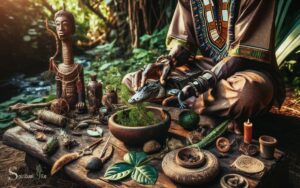Spiritual Uses of Iroko Tree: Strength!
The Iroko tree, native to the tropical regions of Africa, is revered for its spiritual significance as well as its practical uses. It is commonly believed to be the dwelling place of spirits and gods in various African cultures.
Due to its robustness and longevity, it is often associated with strength and is used in traditional rituals and as a protective emblem.
The wood of the Iroko tree is employed in crafting sacred objects and statues that play central roles in worship and spiritual ceremonies.
The spiritual uses of the Iroko tree can be attributed to the beliefs and traditions that surround it:
For example, among the Yoruba people, the Iroko tree is considered a sacred entity, and it is often at the center of various spiritual practices and community gatherings.
The majestic Iroko tree stands as a testament to the deep spiritual connections embedded within African cultural heritage, offering both a link to the divine and a symbol of communal strength.

Key Takeaway
Symbolism in African Spirituality
In my experience, the symbolism of the Iroko tree in African spirituality is deeply rooted in its association with ancestral connections and spiritual protection.
The Iroko tree is revered as a link to the spirit world, representing the embodiment of the ancestors’ wisdom and guidance. It is believed to serve as a meeting point between the living and the dead, fostering a sense of continuity and unity within the community.
The tree’s towering presence and longevity also symbolize resilience and strength, providing a sense of spiritual protection and stability. Its significance in rituals and ceremonies further solidifies its role as a sacred entity within African spirituality.
Rituals and Ceremonies
I will explore the significance of rituals and ceremonies involving the Iroko tree in African spiritual practices. The Iroko tree holds immense spiritual importance in many African cultures, and rituals and ceremonies are often conducted to honor and connect with its spiritual energy.
During these rituals, people gather around the Iroko tree to offer prayers, perform traditional dances, and make offerings to seek blessings or guidance from the ancestral spirits believed to reside within the tree.
These ceremonies are deeply rooted in tradition and are conducted with utmost reverence and respect for the spiritual significance of the Iroko tree.
The rituals and ceremonies serve as a way to strengthen the connection between the living and the ancestral spirits, fostering a sense of unity and continuity with the spiritual world.
This connection is believed to bring harmony, protection, and guidance to the community. As the rituals and ceremonies conclude, the focus shifts to the sacred offerings and prayers, which further deepen the spiritual connection with the Iroko tree and the ancestral spirits.
Sacred Offerings and Prayers
One significant aspect of the spiritual rituals involving the Iroko tree is the offering of sacred items and the recitation of prayers. When making offerings to the Iroko tree, it is essential to approach with reverence and gratitude, acknowledging the tree’s significance in the spiritual realm.
The offerings are symbolic representations of our intentions and respect for the divine forces embodied by the Iroko tree.
Additionally, the recitation of prayers serves as a means of communication with the spiritual world, expressing our desires, seeking guidance, and giving thanks for the tree’s presence in our lives.
It is a deeply spiritual and personal practice, emphasizing the interconnectedness of all living beings and the natural world.
Through these offerings and prayers, we seek harmony and balance with the spiritual energies embodied by the Iroko tree.
Healing and Protection Properties
The Iroko tree’s healing and protection properties have long been revered in spiritual practices, with its bark and leaves believed to possess potent medicinal and defensive qualities.
In many traditional belief systems, the Iroko tree is considered a powerful source of healing and protection against malevolent forces.
The bark is often used in medicinal preparations to treat various ailments, while the leaves are utilized for their protective properties in spiritual rituals.
| Healing Properties | Protection Properties |
|---|---|
| Treats fevers and infections | Guards against evil spirits |
| Alleviates stomach issues | Provides defense from negative energy |
| Aids in wound healing | Creates a shield of spiritual protection |
The Iroko tree’s significance in healing and protection demonstrates its esteemed position in spiritual practices and traditional medicine.
Iroko Tree in Divination Practices
An essential aspect of spiritual practices involving the Iroko tree is its role in divination practices. The Iroko tree is revered for its ability to enhance spiritual communication and insight.
In divination, it serves as a conduit between the earthly realm and the spiritual realm, allowing practitioners to connect with higher powers and receive guidance.
The significance of the Iroko tree in divination practices is deeply rooted in the belief that it holds profound wisdom and possesses the ability to reveal hidden truths. Its presence is thought to bring clarity to complex situations and illuminate the path forward.
Through divination rituals conducted near the Iroko tree, individuals seek enlightenment and solutions to their dilemmas, embracing the tree’s sacred energy and ancient wisdom.
Ancestral Connections and Commemoration
My family has maintained a profound ancestral connection to the Iroko tree for generations, honoring the wisdom and legacy passed down through the ages.
The Iroko tree serves as a living link to our ancestors, embodying their strength, resilience, and enduring presence in our lives. We gather beneath its majestic branches to commemorate and honor those who came before us, seeking guidance and inspiration from their spirits.
Through rituals and ceremonies, we pay homage to our ancestors, seeking their blessings and wisdom as we navigate life’s challenges. The Iroko tree stands as a symbol of continuity, reminding us of the enduring bond we share with our lineage.
It is a place of reflection, where we connect with our roots and find solace in the knowledge that our ancestors’ spirits watch over us.
Taboos and Folklore
Growing up, our elders often shared with me the many taboos and folklore surrounding the sacred Iroko tree. It’s fascinating how these beliefs have been passed down through generations, shaping our cultural practices and reverence for this majestic tree.
Here are some deeper insights into the taboos and folklore:
- Protection of Sacred Sites: The Iroko tree is believed to be the dwelling place of spirits and deities, and as such, it is strictly forbidden to harm or desecrate these trees.
- Respect for Ancestors: The Iroko tree is considered a symbol of the ancestors’ presence, and it is taboo to disrespect or dishonor the tree in any way.
- Healing and Cleansing Rituals: Folklore dictates that the Iroko tree possesses powerful healing energy, and it is often used as a focal point for traditional medicinal and cleansing rituals.
Understanding these taboos and folklore helps us appreciate the deep spiritual significance of the Iroko tree in our culture.
Conclusion
The iroko tree holds a significant place in African spirituality, serving as a symbol of strength, connection to ancestors, and protection.
Its use in rituals, ceremonies, and divination practices reflects the deep-rooted traditions and beliefs of the culture.
With its healing properties and sacred offerings, the iroko tree continues to play a vital role in spiritual practices, connecting people to their past and providing a sense of guidance and protection for the future.






